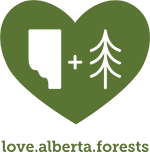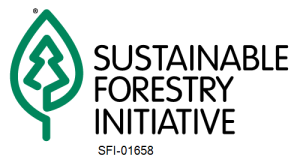Mountain Pine Beetle
The mountain pine beetle (Dendroctonus ponderosae Hopkins) is a member of the bark beetle family, and is the most damaging insect pest of pine trees in western North America. The adult beetles are black and 5-7 mm long. The larvae are small grubs found in the inner bark.
The normal range of mountain pine beetle distribution ends along the Rocky Mountains. Most of the lodgepole pine forest in Alberta has evolved without the presence of mountain pine beetle. If the beetles are not managed while the populations are low, severe damage to pine stands can result. Outbreaks can destroy thousands of hectares of mature pine forest in a single year. Currently, B.C. is experiencing a major mountain pine beetle outbreak.
The mountain pine beetle continues to be a threat in Alberta. Mature pine forests along the eastern slopes, especially by the Alberta/BC and Alberta/U.S. borders, are most vulnerable to mountain pine beetle attack. There are more than 2 million hectares of pine forests along the eastern slopes with an estimated commercial value of $23 billion. These forests are being closely monitored.
Banff National Park has taken action to mitigate the epidemic that escalated in the park in 2002. Since the winter of 2002, 2,725 beetle attacked trees were cut and burned. Two hundred and fifty colonized trees were hand felled and burned, others will be removed in the same manner. Silvertip and Three Sisters Mountain Village has completed their surveys and each treated 30 infested trees. The Town of Canmore has surveyed Harvie Heights and has treated infested trees in that area.
Look for the following Signs and Symptoms:
-
Cream coloured resin (pitch) oozing out of beetle entry holes (pitch tubes) on the tree trunk.
-
Boring sawdust found in bark crevices and around the base of the tree.
-
Egg galleries (J-shaped and up to 41 cm long) under the bark, beginning above the entrance holes and running along the grain of the wood.
-
Greyish blue sapwood caused by blue-stain fungi carried by the beetles.
-
Yellowish-green to reddish-brown needles throughout the crown of hte attacked pine.
-
Woodpecker damage, often leaving a reddish appearance to tree trunks.
Spruce Budworm
Spruce budworm (Choristoneura fumiferana) is one of the most severe forest defoliators in North America. Spruce budworm caterpillars damage trees by feeding on the current year’s needles, conelets and occasionally on mature needles.
The risk is high in 2006 in the south-western part of the province (near Peter Lougheed Provincial Park) and moderate in Willmore Wilderness Park.
Look for the following Signs and Symptoms:
-
Defoliation of the current year’s growth.
-
New greenish egg masses found in the fall on the underside of needles or old whitish egg masses on older needles.
-
Silken webbing seen in May/June around needles and shoots.
-
Spruce budworm larvae found in late May to June on open shoots.
-
Rusty brown tree crown in July, caused by the dead brown needles and pupal cases becoming entangled in silken webbing.
Lodgepole Pine Dwarf Mistletoe
Lodgepole pine dwarf mistletoe (Arceuthobium americanum Nutt.) is a parasitic flowering plant that penetrates its host tree and interrupts the normal growth and function of the branch or stem. Dwarf mistletoe is one of the most serious diseases to infect, damage and kill merchantable lodgepole pine and jack pine.
Look for the following Signs and Symptoms:
-
Profuse and distorted branching (witches brooms).
-
Twisted, spindle-shaped swellings on branches.
-
Greeish-yellow aerial shoots of the mistletoe with tiny scale-like leaves, growing on the affected stems or branches.
-
Basal cups (shoot bases), which remain attached to the branches when the shoots disintegrate.
Armillaria Root Disease
Armillaria root disease refers to diseases caused by Armillaria species. It is one of the most important diseases of the forest trees and in particular, one of the most serious diseases of young conifers in Alberta.
Look for the following Signs and Symptoms:
-
White mycelial fan found between the bark and wood around the root collar and affected roots of the tree
-
Abnormal amount of resin produced around the root collar of the tree.
-
Dark brown rhizomorphs on roots or in the soil, and often brown or honey-coloured mushrooms at the base of the tree in the fall.
-
Dull green yellow, or reddish-brown foliage (needles) over the whole tree (true for young trees only.



